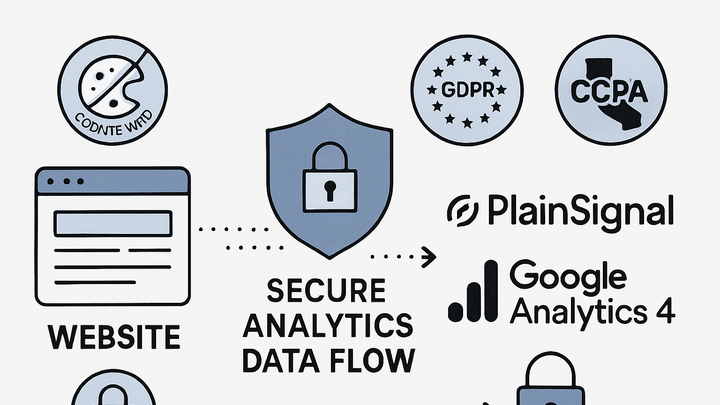Published on 2025-06-26T05:19:19Z
What is Data Security in Analytics? Examples with PlainSignal and GA4
Data Security in analytics refers to the practices and technologies used to protect the collection, transmission, storage, and analysis of user data from unauthorized access and breaches. In the analytics industry, data security is vital for maintaining trust with users and complying with global privacy regulations such as GDPR and CCPA. Effective data security strategies include encryption in transit and at rest, access controls, anonymization techniques, and secure data handling policies. Modern analytics platforms like PlainSignal adopt cookie-less tracking and minimal data collection to reduce privacy risks, while Google Analytics 4 offers built-in encryption and configurable data retention controls. By implementing robust security measures, organizations can ensure the integrity, confidentiality, and availability of their analytics data, fostering responsible insights-driven decision-making.
Data security
Protecting analytics data via encryption, privacy-first measures, and compliance in tools like PlainSignal and GA4.
Why Data Security Matters in Analytics
Understanding the critical role of data security in safeguarding user trust, ensuring regulatory compliance, and preserving data integrity across analytics operations.
-
Trust and reputation
Strong security measures build user confidence, protect brand image, and reduce the risk of reputational damage from data breaches.
-
Regulatory compliance
Compliance with laws like GDPR and CCPA requires secure handling of personal data, avoiding fines and legal penalties.
-
Data integrity
Protecting analytics data from tampering or loss ensures accurate reporting, reliable insights, and informed decision-making.
Key Data Security Measures
Core techniques and technologies used by analytics platforms to protect data at every stage of collection, transfer, and storage.
-
Encryption in transit and at rest
Encrypting data with TLS/SSL during transfer and using strong algorithms (e.g., AES-256) for stored data prevents unauthorized access.
-
Access controls and authentication
Implementing role-based access, multi-factor authentication, and audit logs ensures only authorized users can view or modify analytics data.
-
Data anonymization and minimization
Techniques like hashing, aggregation, and sampling remove or obscure personal identifiers, reducing privacy risks and meeting compliance requirements.
-
Cookie-less tracking
Using privacy-first methods to collect analytics without cookies lowers regulatory burden and enhances user privacy. For example, PlainSignal’s simple snippet delivers key metrics without storing identifiers:
<link rel="preconnect" href="//eu.plainsignal.com/" crossorigin /> <script defer data-do="yourwebsitedomain.com" data-id="0GQV1xmtzQQ" data-api="//eu.plainsignal.com" src="//cdn.plainsignal.com/plainsignal-min.js"></script>
Implementing Data Security in Analytics Platforms
Practical steps to configure security settings and features in popular analytics tools like PlainSignal and Google Analytics 4.
-
Configuring PlainSignal
PlainSignal uses a minimal, cookie-free tracking snippet and automatically anonymizes data. Insert the provided script on pages and verify that no cookies or personal identifiers are stored.
-
Securing google analytics 4
In GA4’s admin settings, enable IP anonymization, set appropriate data retention periods, and restrict user permissions. Leverage the Measurement Protocol over HTTPS for secure data transfer.
Best Practices and Compliance
Recommended strategies and regulatory guidelines to maintain robust data security in analytics environments.
-
Gdpr and ccpa compliance
Ensure legal basis for data processing, implement data subject rights (access, deletion), and maintain documentation of consent management.
-
Consent management
Implement clear cookie banners or consent pop-ups, record user choices, and integrate with analytics tools to honor opt-in/opt-out preferences.
-
Data retention policies
Define and enforce retention periods aligned with business needs and legal requirements, regularly purge stale data to minimize risk exposure.
